
Kyle Börner
Cofounder, Chief Creative Marketer and Strategist
- October 21, 2019
- 1:16 pm
- UPDATE:
- April 18, 2024 1:11 pm
UPDATE: Google released another Core Algorithm Update in May!
You’ll now see two tables of content below to give you the secrets you need to improve and sustain your Google Rankings in 2020. Your competition doesn’t know this yet, so don’t wait. Act now!
When people ask me, “How do I rank on Google?”, I respond with another question, “Did you know that following Google on Social Media can sustain and improve your Search Engine Rankings?
If you read my friend Kyle’s blog post on Conversion Rate Optimization, you would have discovered that a March Tweet from Google notified their followers (you should be one, too!) of a broad Core Algorithm Update that would forever change their focus from keywords to topics.
This was no ordinary update 
It changed SEO across the board 
Companies who ranked Page 1 for years fell to page 5 -10 
When you look at your calendar and realize that the update was released 200+ days ago, and when you recall that it takes 3 to 6 months to realize an increase in Google rankings after applying new SEO techniques, and when you notice that most SEO agencies are still talking about “Keywords”
The time is NOW for you to follow a Topic Focused SEO Strategy to sustain and improve on your rankings today, and to run by your competition tomorrow while they likely stick with their archaic Keyword Focused SEO Strategy 🧟♂️.
Start by following my simple 4 step guide to satisfying Google’s latest Core Updates… and to satisfying Google’s customers’ search queries, and thereby your prospective customers’ search queries, too 
KEYWORD FOCUSED STRATEGY

TOPIC FOCUSED STRATEGY

In addition to this quick guide, I’m also offering you a free Topical Authority Content Silo [a $2,500 value] to help you make quick gains on your SEO Roadmap. AND, you can also run a free SEO Health Check right on our website. AND, we’re offering you a free 30 minute SEO consultation [a $1,250 value].
Why 3 free offerings? Because we know business is a two-way street, and we’re committed to the same things that you value, at the same level, for the long haul.
How to Rank on Google after the 2019 Core Update
click the red text below to jump to a specific section
How to Rank on Google after the 2020 Core Update
click the red text below to jump to a specific section
“Solving big problems is easier than solving smaller problems.” – Sergey Brin, Cofounder of Google
1. Not all Mobile Optimized Websites are truly Mobile Optimized
Short answer: You may have more work to do.
Years ago, Google’s bots followed desktop-first indexing when crawling the web. As of July 2019, 63% of Google’s U.S. organic search traffic comes from mobile devices. We shouldn’t be surprised then that Google now uses mobile-first indexing for the majority of the pages in search results.
What does this mean for you?
Google will more than likely use the mobile version of your web pages for indexing and ranking, not desktop.
WARNING! Do not rely on trendy online tools to determine whether your website is optimized for mobile. Mobile Responsiveness is a strategy in-and-of-itself and should have considerable time invested in it.
If you use any online tool, use Google’s Mobile-Friendly Test first to collect useful data that your web designer / developer can use to enhance Page Load Time and other Key Performance Indicators that are valued by Google.
Furthermore, do not make the mistake of simply crunching your desktop website down into a mobilized version. While the value and quantity of your content are still important on mobile, your website’s visual hierarchy should be different on mobile because you have a shorter amount of time to capture and sustain your mobile visitor’s attention.
Both of us know how much Google values your site’s Time on Site KPI (also known as Session Duration) for Page Rank consideration, so keeping in mind that desktop users continue to stay on websites longer than mobile users, your focus should be on keeping mobile visitors’ attention longer, not desktop.
You can accomplish this on the mobile-version of your website by prioritizing your Unique Selling / Value Proposition above the fold, delivering greater context between your visitors’ search queries and your page’s Title and Meta Tags, consolidating the quantity of copy and thereby using larger font sizes, compressing images to enhance loading times… and there’s more where that came from, trust me (and we’ll share that with you during the free consultation).
2. Start Performing, Prioritizing Topical Research
This is not keyword research. This is topical research. As much as I may use the concept ‘keyword’ in this blog post, please understand that it’s being used to complement its ‘Parent Topic’.
Targeting individual keywords is no longer the path to take for quick and sustained SEO gains on Google.
Google knows that Page 1 ranking web pages also rank for 100’s, 1,000’s… even 10,000’s of other keywords. Why is this important?
The web page that is ranking for 1,000’s of keywords is also getting 100’s or 1,000’s of visitors for each keyword, demonstrating strong relevance to Google users.
I’m a big Crossfit guy 

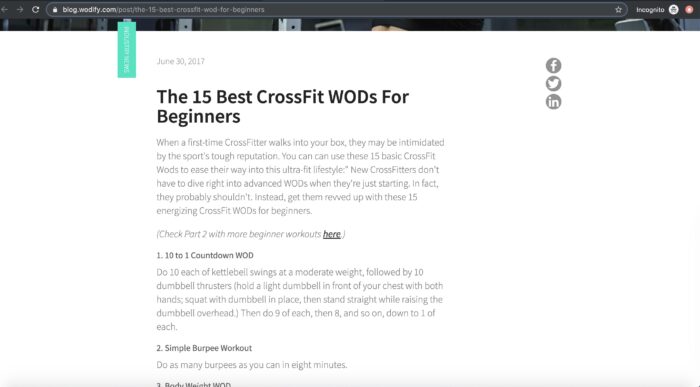
As you can see, it was published back in June of 2017, but it still gets 20,000 monthly visitors and it ranks for 1,997 keywords! That’s amazing! Now if I wanted to start a Crossfit website, I could learn a lot from this single page’s keyword data. Scanning up and down keyword rankings by traffic volume, you can also see that they also rank for ‘crossfit workouts’, ‘crossfit exercises’, ‘crossfit wods’, ‘workout of the day’, ‘crossfit for beginners’ and ‘workout routines for beginners’. Are you seeing how I would organize my Crossfit website’s Navigation Bar using Topical Relevance? I could keep going but you see the pattern here:
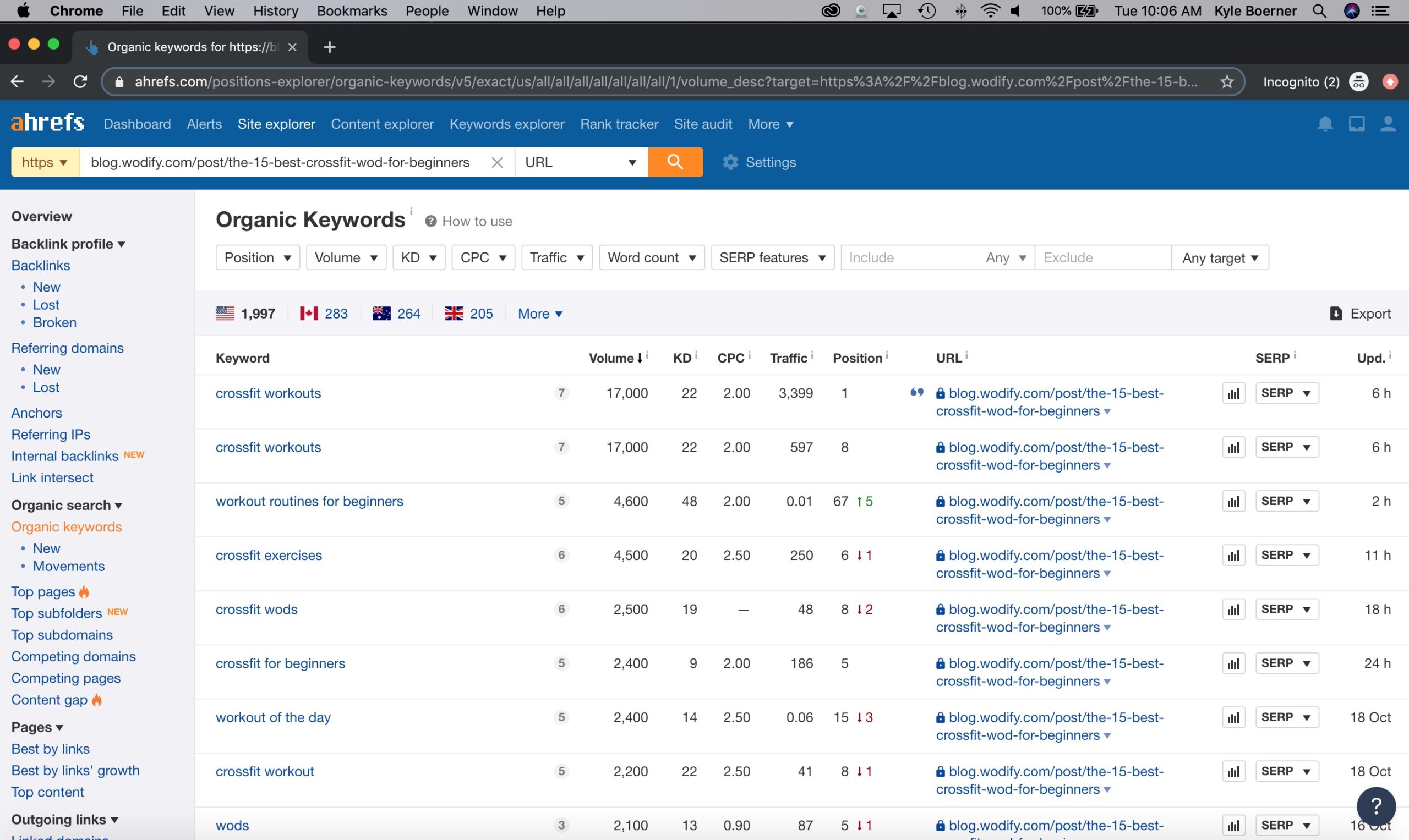
Takeaway: all of these keywords are essentially looking for similar solutions to a few topically categorized problems. To Google, these keyword groupings can be consolidated underneath several “Topical Umbrellas”. So if you find an article [preferably one your competition wrote] that is ranking high for a topic(s) that you want to rank high for, aim for similar keywords and Topical Breadth, not a single focused keyword or topic. This is also applicable to your website’s site architecture, but we’ll visit that later in my post. This is also the best way to reverse engineer the most popular blog posts in your industry/category. Hint hint, wink wink, nudge nudge, say no more, say no more.
3. Start Establishing Your Topical Authority
Once you do the necessary topical research, and for business purposes that means doing heavy-across-the-board topical research, you will want to optimize your content for Topical Authority.
Back to what I was saying about Google’s Core Algorithm Update. Google has always been Smart, but it got Smarter with their latest algorithms, and now they’re classifying top-ranking pages as Topical Authorities for their users’ unique search queries.
To discover who has the best Topical Authority according to Google, I’m now going to spare you from my Crossfit enthusiasm and switch to another passion of mine, hiking.


I’ve hiked all across the United States, from Yosemite to the Adirondack, and I’m all about taking care of my feet (socks are important, too, but I’ll spare the Lieutenant Dan references, 
Looking at the Top 10 SERP rankings for Hiking Boots, what do you notice?
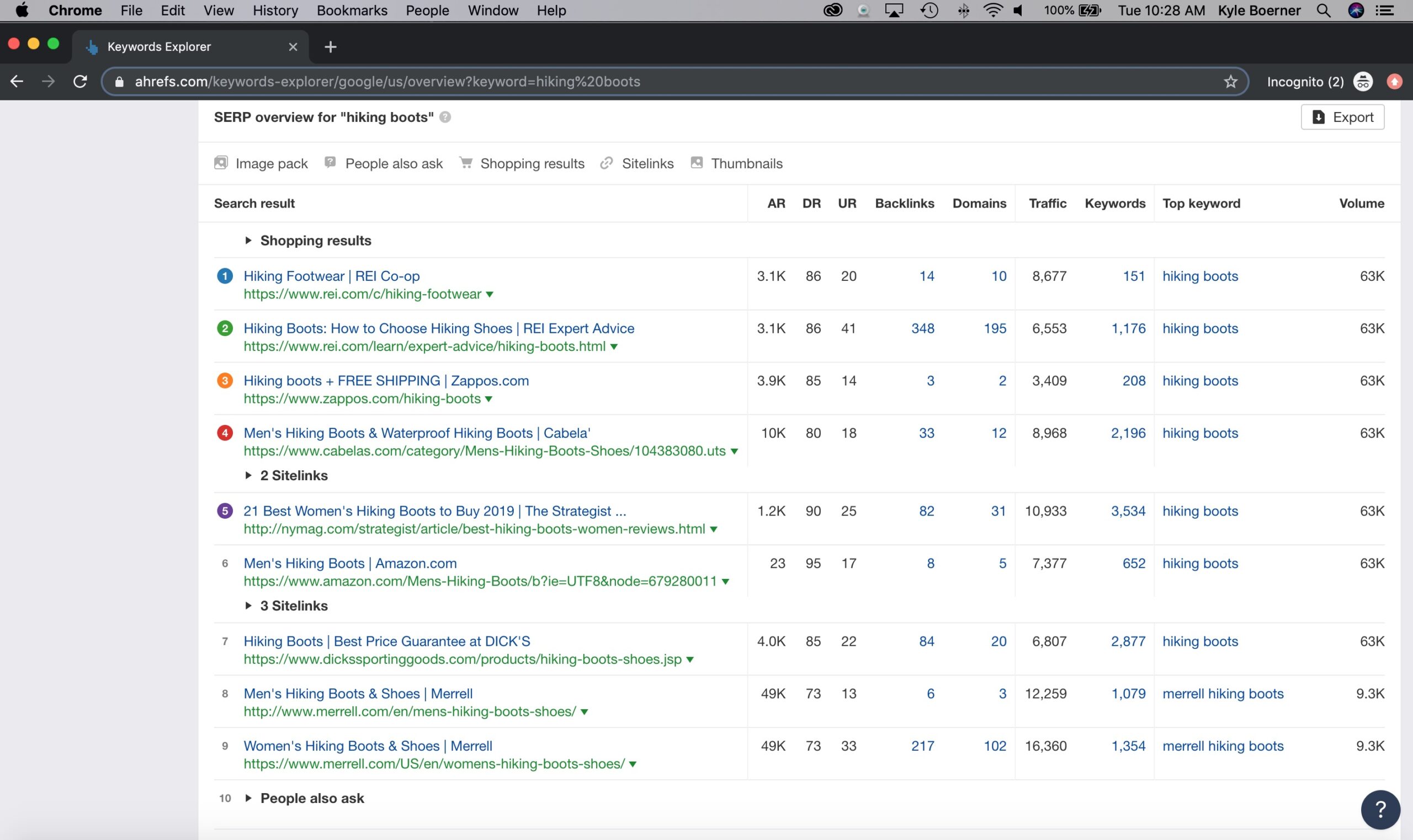
Who has the most traffic, keywords and backlinks. Well, it’s NOT the number one ranking page for Hiking Boots! SEO pundits lose their mind!!!
With 99% certainty, I can tell you the reason REI ranks #1 is that it is Topically Dominant for the topic of hiking boots… and all the subtopics [ keywords ] below it.
So how do you build Topical Authority?
I can tell you backlinks still do matter, but don’t get just any backlink. Use high quality SEO software like Ahrefs that helps you find topically relevant and highly ranked websites and blogs and social media channels for acquiring backlinks. But backlinks don’t matter as much as building Topical Relevance across your website by incorporating Content Silos and Internal Linking in your site structure (building topical authority will attract backlinks organically!).
What are Content Silos, and What is Internal Linking you ask?
Content Silos are a methodical way of organizing your website’s navigation into groups, or “Silos”, of related content to establish your website’s keyword-based topical areas. Typically, you start with a Parent Topic page (parent topics = breadth), and then you create pages underneath the Parent Topic that ranks for subtopics / keywords that are found to be relevant to the Parent Topic. I know, but stay with me… Once you do that, you internally link the pages in the Silo, thereby creating relevance for users and Google’s algorithm. Websites structured this way have very high Session Durations.
We work with one of the highest quality pool companies in the world, Crestwood Pools. Once the impact of the March 2019 Update hit, we knew that Crestwood’s site architecture had to be changed [currently under construction] to match Google’s algorithm . We created several new silos that were designed to demonstrate Topical Authority to both visitors and Google. Here’s one of their Content Silos below, alongside their old “Silo” of similar content. Which do you think would sustain High Session Durations longer, thereby demonstrating Topical Authority to Google?
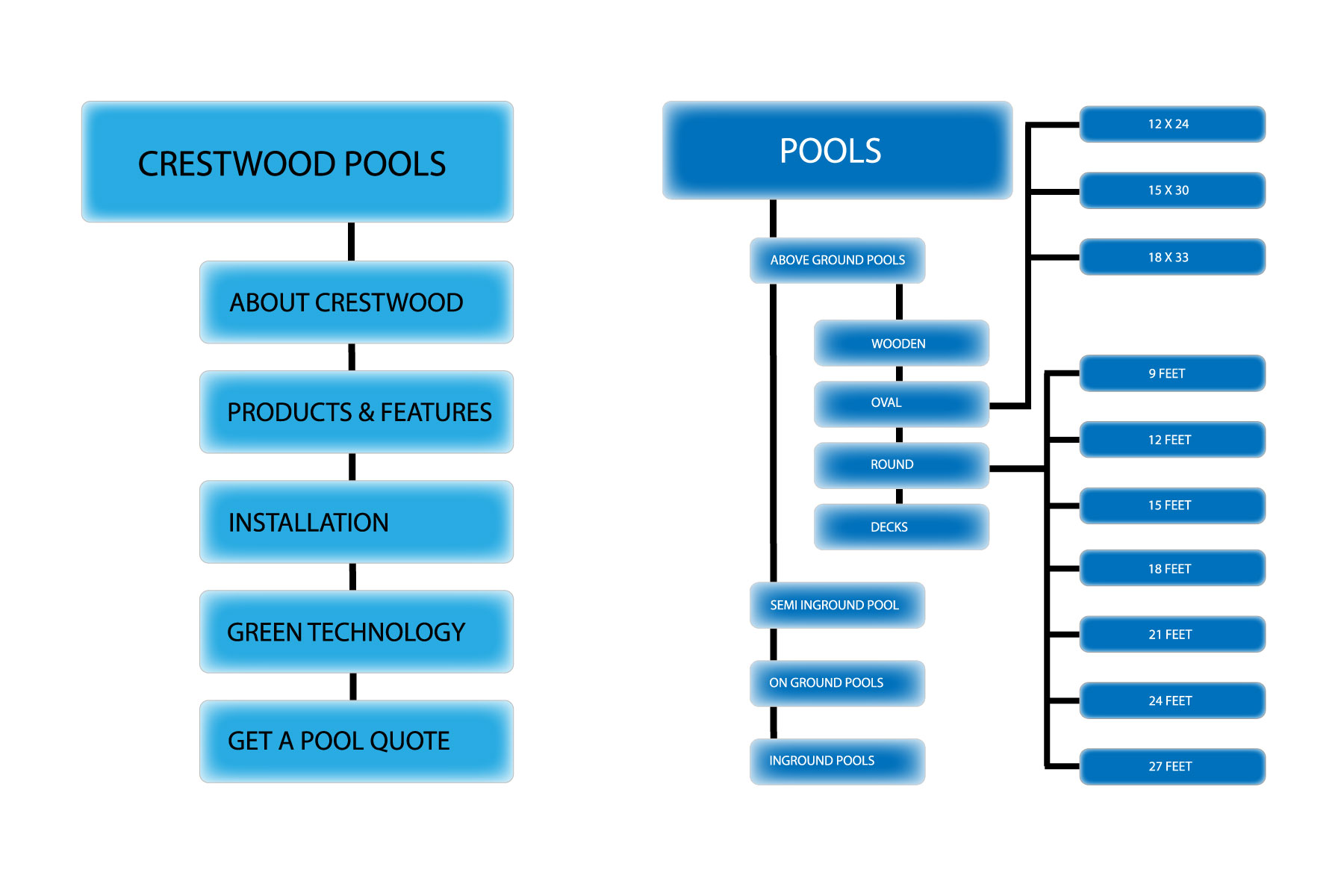

Another Ahrefs plug. If I wanted to find parent topics and subtopics for ‘swimming pools’, I’d use their Keyword Explorer to generate reports like this:
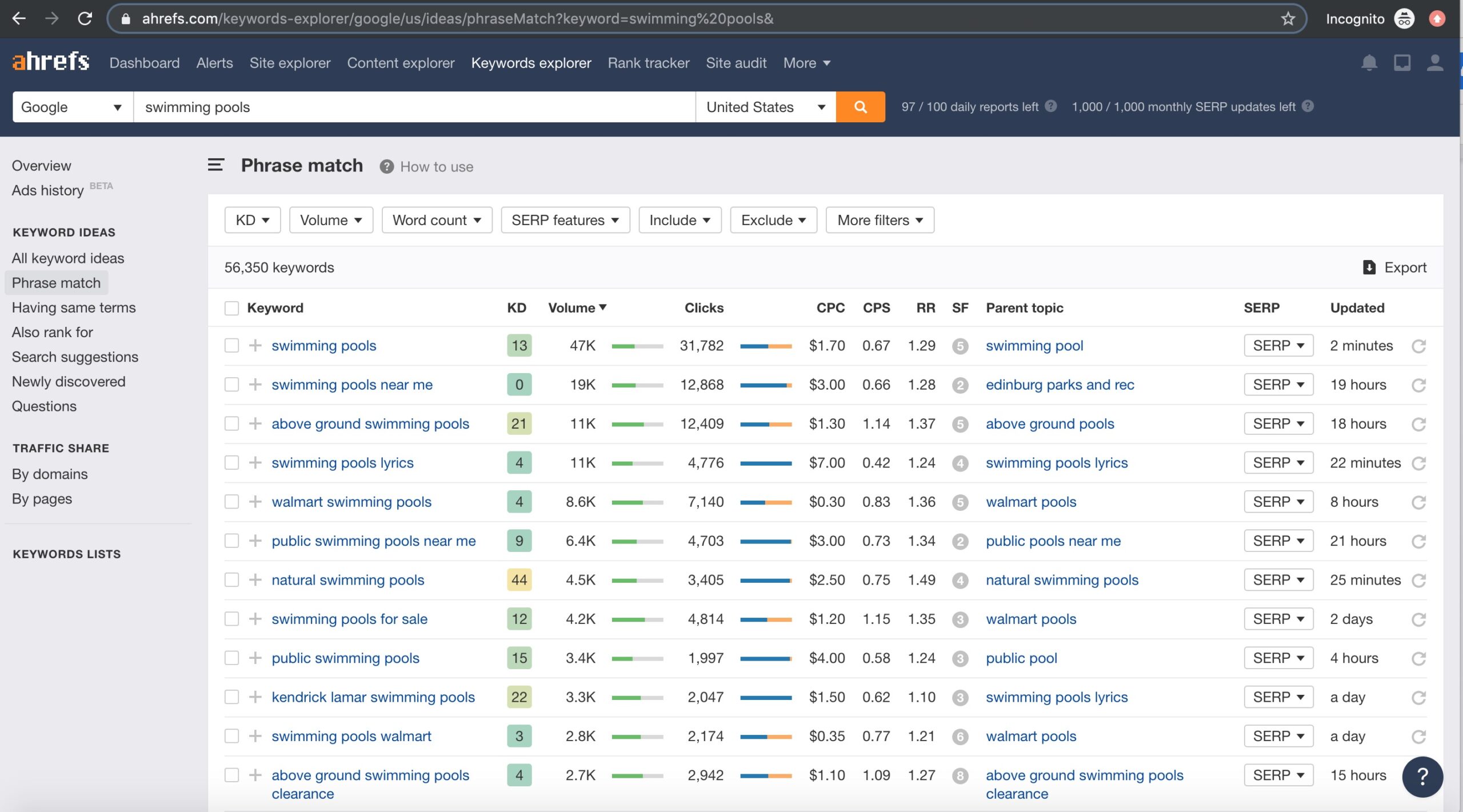

As you can see, ‘swimming pool’ is the parent topic to ‘swimming pools’… however with a few more clicks, the real parent topic we chose to target was simply ‘pools’. No billiards here!
4. But Don't Forget to Answer Your User's Query
If you wanted to learn how to install a pool in your backyard and I offered you the following content—a VHS tape, a YouTube video, or a 39 page set of black and white instructions—which one would you choose?
To further demonstrate to Google that you offer the most topically relevant website and content, you need to reach the right KPIs (key performance indicators) in Google Analytics that tell Google you’re answering users’ questions and thereby delivering a positive user experience. Here are four that I recommend you have a hyper focus on:
- Average Session Duration
- Pages per Session
- Bounce Rate
- Goal Conversion Rate
To reach those KPI numbers, you need to deliver the ‘right’ content that the users want for answering their query—the right type, format, length, angle, takeaway (download for example), and more. Tip: be sure to add this insight to your future Editorial Calendars.
Back to the Hiking Boots example, you can see this is a mix of users who want to learn about products, browse and purchase hiking boots, and users who want to learn more about hiking boots in general.



No surprise that REI ranks 1 and 2 and satisfies both content requests [product options and shopping guidance]. They have some great SEO personnel over there at REI!
You should also be concentrating on how the Titles and Meta tags are written, whether or not the page has significant social media volume [great content is shareable / viral content], and the mobile responsiveness grade of the top ranking pages.
But, as I referenced in the calendar tip, you’ll also want to schedule content refreshers.
Think of it like an Apple, not as much as an Avocado. Google does include ‘date of creation’ and ‘date of last update’ in their rankings. It really matters. When we detect the slightest dip in traffic or conversions on client websites, we go in, make quality updates to popular content, and voila!, the traffic and conversions regain momentum. This is a low-hanging-fruit strategy my friends!
If you use project management software like Asana or Monday; instead of closing a content marketing project when it’s launched and distributed, add tasks that include the following:
- update the post / page after 3 months
- update the post / page after 6 months
- review content’s KPIs at year end
- review SERP results at year end
- update the page after 12 months
- repeat, repeat, repeat…
This is why you should create “Best of >insert year<” blog posts. People love these, and you can update them and keep the content relevant forever.
5. Helpful Tools for ranking on Google in 2019 and 2020
1. Fix Your SEO Errors
I shared last year that Google’s Mobile-first indexing was impacting search rankings for thousands of heavy, dynamic websites. There’s much more to it than how heavy your website is, and luckily for you and me Google created a free resource to determine whether or not your website is mobile friendly and full of SEO errors.
It’s a quick 3-step process.
1. Add Google’s Lighthouse Extension to your Chrome browser
2. Open your website in a Google Chrome browser window
3. Click the Lighthouse icon on the top-right of your Chrome browser window
The report will give you very thorough insight into what Google likes about your website, and what Google doesn’t like about your website. Review the red and yellow details with your marketing team or digital agency to create initiatives to fix the errors that are impacting your Google search rankings. If you need help reviewing the Lighthouse report, please email me at keith@whitebuffalocreative.com
Wait! Before you go on to the next step for ranking on Google in 2020, be sure to doublecheck this all too frequent error. . . . .
Please make sure there are no duplicate Title Tags and Meta Descriptions. We’ve read a handful of reports that demonstrated lowered Google search rankings for websites with duplicate title tags or meta descriptions. This is an easy fix to get out of the way today. If you do find duplicate title tags or meta descriptions and fix them, be sure to have Google recrawl those individual pages via Search Console.
2. Your Industry and Audience Matters
If you’ve worked with us, or spoken with us on a free consultation call, you know that we’re all about creating content for our clients that is not just SEO-friendly (keywords, topics, alt data, etc.), but that’s relevant to current Google search queries and their respective analytics.
“Wait a minute, isn’t that the same thing?”
Yes and No. Let me explain. . .
This content path starts by leveraging several SEO softwares to determine what content is trending on Page 1 of Google (and social media) for specific queries, keywords, and topics. For example, content with a “Top 10 hiking boots” theme may have ranked on Page 1 in June 2019 for the search query “best hiking boots“, however a “best hiking boots” search query in June 2020 may have resulted in content that is more brand focused, such as “LL Bean hiking boots“.
You have to stay on top of your audience and how it responds to industry content for the most popular and trending Google search queries. If you don’t already have an SEO Calendar that reminds you to track your industrial / audience search query activity on a monthly basis, you should definitely create one so you can respond in near realtime and stay ahead of your competition.
But why stop there? There’s another calendar you need to use to rank on Google post the 2019 and 2020 core algorithm updates. . .
3. Create an SEO Update Calendar
Does your website have Internet Dust?
I can tell you with the utmost confidence that the answer to that question across the globe is a resounding, “Yes.”
What do I mean by Internet Dust? If you have blog posts that were published a month, months, or years ago, and they haven’t been touched since the day they were published, they’re covered in Internet Dust, and Google wants you to spray Pledge all over your website.
Ok, I don’t want you to spray your website with Pledge, but I do want to challenge you to update your blog posts, and website overall, on a frequent basis.
“But wait, I don’t have the time or resources to update content on a daily basis!”
While some large brands do update content on a daily basis, I’m definitely not recommending daily updates.
However, I am recommending that you do whatever it takes (see previous step) to keep your website’s content relevant for your audience and better than your competitors’ content.
When creating an SEO Update Calendar, be sure to track and respond to the following examples with updates or other measures:
- when traffic for a page or post has consistently gone down, first create initiatives to update the page or post, but if the downward trend continues delete the page and 301 redirect it.
- add conversion rate optimization to your pages and posts, especially psychological triggers that will keep your content actionable.
- consider adding other forms of content to your pages and posts, including video, social sharing options, and interactive content.
- make sure your internal linking structure is properly organized and the most important pages are continuing to see the highest quantity of internal link direction.
- when it comes to blog posts, one of the easiest things to do is make more posts Evergreen. this blog post is Evergreen because I can update it with more actionable tips next year and rename it “How to Rank on Google in 2021“.
4. Make Your Short Pages Long, Like Rapunzel Long
This is one of the easiest ways to respond to the previous step. While shorter and simpler can deliver home the message faster, Google also rewards pages and posts that backup their content with the highest quantity of credible information.
If you were hiring someone, and you asked three candidates to expand on their relevant sales experience, would you hire the person who spoke for 1 minute, 5 minutes, or 15 minutes? Hey, maybe you liked the person who only spoke for 1 minute, but also consider the sheer quantity of opportunities to use more related keywords, add more backlinks and internal links, insert photos and images with proper alt data, and possibly transform a long-formed post into a future eBook.
The longer the better. It’s by far the easiest way to keep your content updated and fresh, but always make sure the added content is valuable to your industry and audience and not just fluff.
Lastly, if there are some pages that you are hesitant to add more words, use your favorite SEO software to determine a page or post’s appropriate word count.
Do you need help with SEO?
If you do, that’s okay. Fill out the form below and we’ll be in touch.



